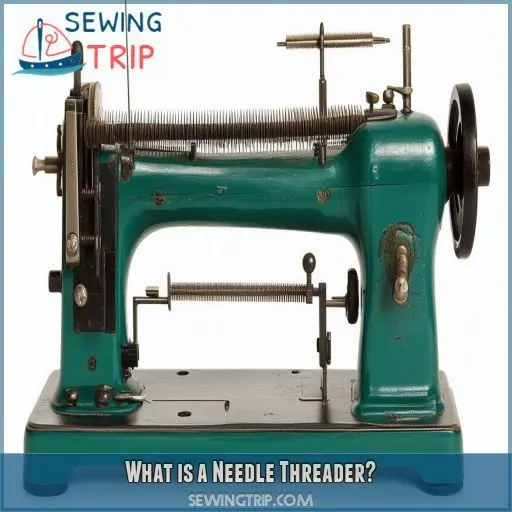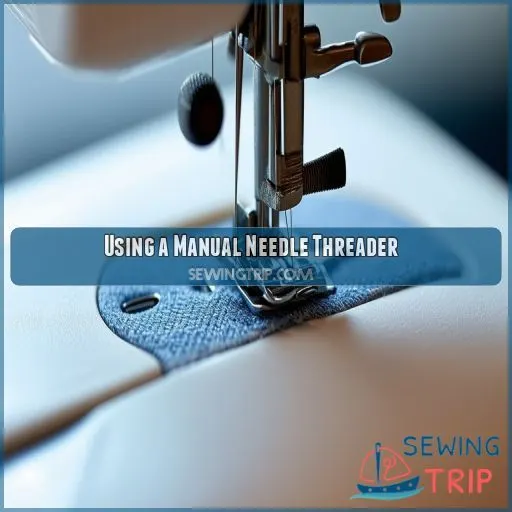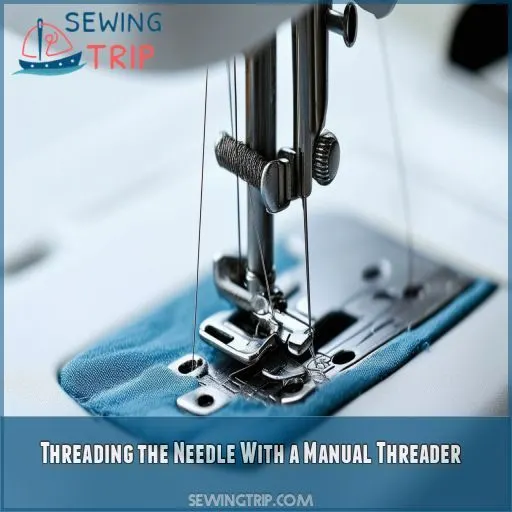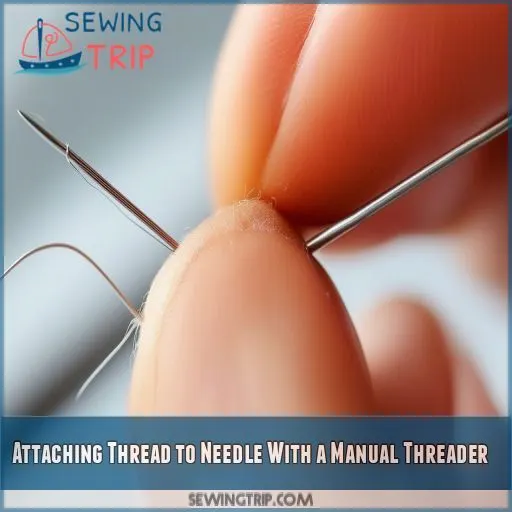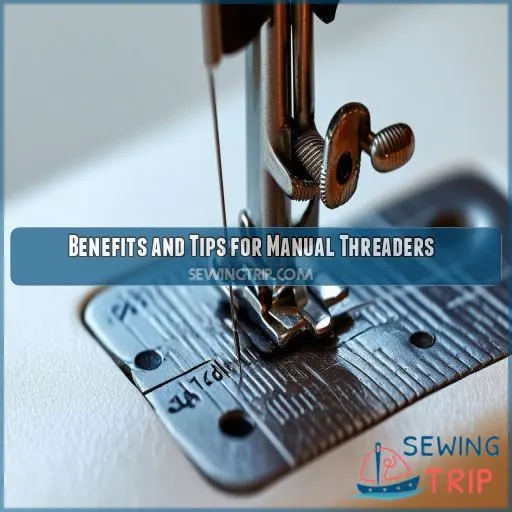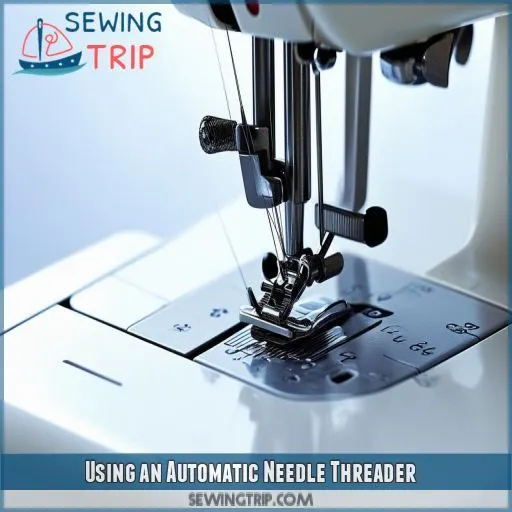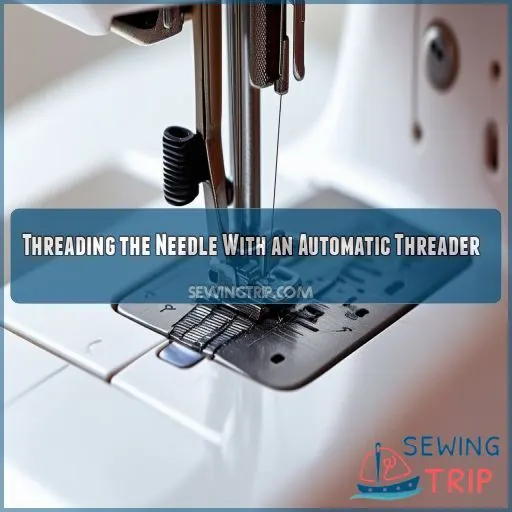This site is supported by our readers. We may earn a commission, at no cost to you, if you purchase through links.
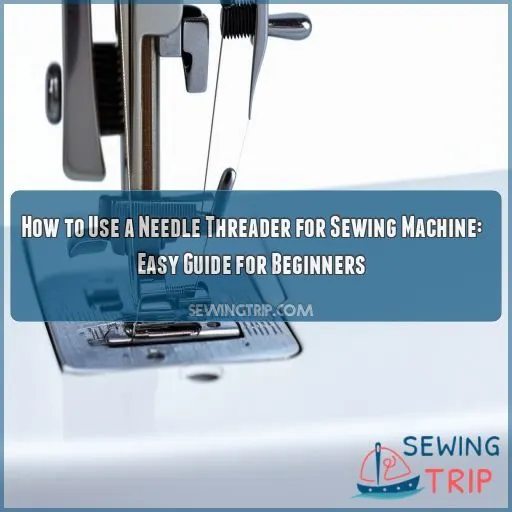 Struggling to thread your sewing machine needle? You’re not alone. A needle threader can be a game-changer, making this tricky task a breeze.
Struggling to thread your sewing machine needle? You’re not alone. A needle threader can be a game-changer, making this tricky task a breeze.
In this easy guide for beginners, you’ll learn how to use a needle threader for your sewing machine. We’ll cover both manual and automatic threaders, providing step-by-step instructions to master this essential skill.
Table Of Contents
- Key Takeaways
- How to Use a Needle Threader for Sewing Machine?
- What is a Needle Threader?
- Using a Manual Needle Threader
- Threading the Needle With a Manual Threader
- Attaching Thread to Needle With a Manual Threader
- Benefits and Tips for Manual Threaders
- Using an Automatic Needle Threader
- Threading the Needle With an Automatic Threader
- Troubleshooting Needle Threaders
- Frequently Asked Questions (FAQs)
- Conclusion
Key Takeaways
- Threading a needle doesn’t have to be a hair-pulling experience! With a needle threader, you’ll be stitching up a storm faster than you can say "bobbin."
- Manual or automatic? It’s not just a car thing! Both types of needle threaders can be your new best friend, whether you’re a sewing newbie or a seasoned pro.
- Got the shakes or squinting at that tiny needle eye? No worries! A needle threader is like a seeing-eye dog for your thread, guiding it right where it needs to go.
- Remember, practice makes perfect. You might fumble a bit at first, but soon you’ll be threading needles blindfolded… okay, maybe not blindfolded, but you get the idea!
How to Use a Needle Threader for Sewing Machine?
Using a needle threader for your sewing machine is a game-changer, especially if you’ve got butterfingers or less-than-perfect eyesight.
To use a manual threader, hold it in your dominant hand and the needle in the other. Slip the threader’s wire loop through the needle’s eye until it’s snug in the groove. Now, slide your thread through the wire loop and pull it back through the needle’s eye. Voila! You’ve just threaded your needle like a pro.
This nifty tool saves time, reduces eye strain, and keeps you from jabbing your fingers.
Ready to become a threading wizard? There’s more to discover about mastering this essential sewing skill.
What is a Needle Threader?
If you’ve ever struggled to thread a needle, you’re not alone. That’s where a needle threader comes in handy. It’s a small tool designed to make threading needles a breeze, especially for those with poor eyesight or shaky hands.
Whether you’re using delicate thread or thick yarn, a needle threader can handle various thread weights and needle types. By reducing threading errors and potential needle damage, it’s an essential part of machine maintenance.
This nifty device guides the thread through the eye of the needle, ensuring you’re ready to stitch in no time.
Using a Manual Needle Threader
Now that you know what a needle threader is, let’s explore the use of a manual one. These affordable threaders are ideal for threading thick thread or when your eye coordination is lacking.
You’ll need to hold the threader in your dominant hand and the needle in the other. For stability, you can use a pincushion or cork.
Manual threaders are excellent for hand sewing and mending torn clothing. They’re durable, but it’s wise to have a few on hand. Store them safely to avoid bending.
While not as fancy as automatic needle threaders, they’re reliable for single thread work.
Threading the Needle With a Manual Threader
Now that you’ve got your manual threader ready, let’s address threading the needle. Hold the threader in your dominant hand and the needle in your other hand, eye facing up. Insert the threader’s loop into the needle eye, pushing until the needle rests in the groove.
Next, slide your chosen thread through the threader’s loop. Consider your fabric, needle type, and thread size for satisfactory results. Pull the loose thread end through, creating a loop.
This technique works for various sewing machines and thread colors. Remember, regular machine maintenance ensures smooth threading every time.
Attaching Thread to Needle With a Manual Threader
Now that you’ve threaded the needle, it’s time to secure the thread. Here’s how to attach it:
- Remove the needle from the threader’s groove.
- Fit the needle over the double thread.
- Pinch both thread ends together.
Gently tug the thread out of the threader’s wire hook. If the loose end gets stuck, work it out with your fingers. For unsteady hands, this step might be tricky, but practice makes perfect. Remember, thin or old thread can be more challenging to work with. Once you’ve mastered this technique, you’ll be threading needles like a pro, regardless of the threader’s cost or durability.
Benefits and Tips for Manual Threaders
You’ll find manual needle threaders to be invaluable tools that save time and reduce eye strain when threading your sewing machine. These cost-effective aids are especially helpful if you have poor vision or struggle with hand-eye coordination, making the threading process much easier and more efficient.
Time-Saving Threading Solution
You’ll love how a needle threader speeds up your sewing projects. It’s a time-saving threading solution that’ll cut down on frustration, especially when working with stuffed animals or hardware.
You’ll notice the ergonomic benefits as you thread with ease, reducing project time considerably.
Plus, these durable tools offer cost savings in the long run, making them a smart investment for any sewer.
Improved Vision Assistance
Needle threaders aren’t just time-savers; they’re a boon for those with vision challenges. You’ll find threading needles a breeze, even with imperfect eyesight. Here’s how they help:
- Wire loop catches thread like a fishing line
- Enlarged eye area makes aiming a cinch
- Double thread option for enhanced precision
- Ergonomic design reduces eye strain
With improved vision assistance, you’ll tackle sewing projects with renewed confidence.
Cost-Effective Sewing Aid
Needle threaders not merely aid those with vision issues, but they’re also a budget-friendly sewing essential. You’ll find basic models for just $2-3, making them an affordable addition to your toolkit.
These handy devices work with various threading techniques and are compatible with different thread types and needle sizes.
Remember to store them properly and maintain your machine for ideal performance.
Using an Automatic Needle Threader
While manual needle threaders are handy, automatic needle threaders take convenience to the next level. Built into many modern sewing machines, these nifty devices use a tiny wire hook to do the threading for you. It’s like having a mini-robot assistant!
You’ll find the threader lever near your needle, ready to spring into action. Before using it, make sure your needle’s inserted correctly and your machine’s set up properly.
Don’t worry if it takes a few tries to get the hang of it – soon you’ll be threading like a pro, saving time and eyestrain.
Threading the Needle With an Automatic Threader
Threading your needle with an automatic threader is a breeze once you get the hang of it. Here’s how to do it:
- Pull the threader lever down and insert the hook into the needle’s eye.
- Guide the thread under and over the thread guide, then pass it in front of the needle and under the hook.
- Swing the lever away and move it upwards, letting the hook pull the thread through the needle.
You’ll save time and reduce eye strain with this nifty device. It’s especially helpful if you’re dealing with poor lighting or fine threads. Remember, practice makes perfect!
Troubleshooting Needle Threaders
If you’re having trouble with your automatic needle threader, don’t worry. There are a few common issues you can check. First, make sure your needle is inserted correctly and in the neutral position. Always select a straight stitch before threading. Check for any bends in the threader hook, as these can cause problems. Thread stiffness can also be a culprit. Here’s a quick troubleshooting guide:
| Issue | Possible Cause | Solution |
|---|---|---|
| Thread not catching | Bent hook | Replace threader |
| Needle won’t thread | Incorrect position | Set to neutral |
| Threader misses eye | Wrong stitch | Select straight stitch |
Frequently Asked Questions (FAQs)
How do you use a threader machine?
Don’t worry if you’re new to sewing machines—using a threader’s easy. Turn off the machine, raise the needle, and lower the presser foot. Pull the threader lever down, insert the hook into the needle’s eye, and guide the thread through.
How do you use a needle threader wire loop?
You’ll insert the wire loop through the needle’s eye, pass your thread through the loop, and pull the threader back. As you do, the thread follows, threading your needle effortlessly. It’s a handy trick for tricky threading!
How to thread a needle for beginners?
You’ll need steady hands for this. Hold the needle, eye up. Pinch the thread end, moisten it slightly. Aim carefully and push it through. If you’re struggling, try a needle threader for an easier time.
How do self-threading sewing machine needles work?
Say goodbye to needle-threading woes! Self-threading sewing machine needles have a clever design. You’ll simply guide the thread through a small slit above the eye. The machine then automatically pulls it down, threading the needle effortlessly.
How often should I replace my needle threader?
You should replace your needle threader when it shows signs of wear or damage. Generally, with regular use, consider replacing it every 6-12 months. If you’re a frequent sewer, you might need to replace it more often.
Can needle threaders damage delicate or specialty threads?
Did you know that 90% of sewers use needle threaders? While they’re generally safe, you’ll want to be cautious with delicate threads. Use gentle pressure and avoid pulling too hard. For specialty threads, consider hand-threading to prevent damage.
Are there alternatives to needle threaders for arthritic hands?
You’ve got options! Try needle grippers, self-threading needles, or magnetic needle threaders. These tools can ease the strain on arthritic hands. Alternatively, consider asking a friend or family member for help when threading needles.
Whats the largest needle size a threader can accommodate?
You’ll find most needle threaders work with needles up to size 90/ For larger sizes, you’re better off threading manually. Remember, thicker needles have bigger eyes, so they’re often easier to thread without assistance.
Can I use a needle threader with invisible thread?
You might be surprised, but yes, you can use a needle threader with invisible thread. It’s tricky, but not impossible. Hold the thread taut, guide it carefully through the threader’s loop, and you’ll succeed with practice.
Conclusion
Time is thread, and with a needle threader, you’ll save plenty of it. You’ve now learned how to use a needle threader for your sewing machine, both manual and automatic.
These handy tools can make threading a breeze, saving time and reducing eye strain. Remember, practice makes perfect.
As you become more comfortable with your threader, you’ll wonder how you ever managed without it. Keep exploring and refining your sewing skills, and you’ll be stitching like a pro in no time.

